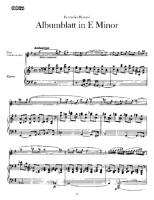Ferrucio Busoni Free Sheet Music
 Ferruccio (Dante Michelangelo Benvenuto) Busoni (April 1, 1866 – July 27, 1924) was an Italian composer, pianist, editor, writer, piano and composition teacher, and conductor.
Ferruccio (Dante Michelangelo Benvenuto) Busoni (April 1, 1866 – July 27, 1924) was an Italian composer, pianist, editor, writer, piano and composition teacher, and conductor.Most of Busoni's works are for the piano. Busoni's music is typically contrapuntally complex, with several melodic lines unwinding at once. Although his music is never entirely atonal in the Schoenbergian sense, his mature works, beginning with the Elegies, are often in indeterminate key. He was in contact with Schoenberg, and made a 'concert interpretation' of the latter's 'atonal' Piano Piece, Op. 11, No. 2 (BV B 97), in 1909. In the program notes for the premiere of his own Sonatina seconda of 1912, Busoni calls the work senza tonalità (without tonality). Johann Sebastian Bach and Franz Liszt were key influences, though late in his career much of his music has a neo-classical bent, and includes melodies resembling Mozart's.
Some idea of Busoni's mature attitude to composition can be gained from his 1907 manifesto, Sketch of a New Aesthetic of Music, a publication somewhat controversial in its time. As well as discussing then little-explored areas such as electronic music and microtonal music (both techniques he never employed), he asserted that music should distill the essence of music of the past to make something new.
Many of Busoni's works are based on music of the past, especially on the music of Johann Sebastian Bach (see below). The first version of Busoni's largest and best known solo piano work, Fantasia Contrappuntistica, was published in 1910. About half an hour in length, it is essentially an extended fantasy on the final incomplete fugue from Bach's The Art of Fugue. It uses several melodic figures found in Bach's work, most notably the BACH motif (B flat, A, C, B natural). Busoni revised the work a number of times and arranged it for two pianos. Versions have also been made for organ and for orchestra.
 Sheet Music Drive is a web site for those who wants to access popular sheet music easily,
letting them download the sheet music for free for trial purposes.
It's completely free to download and try the listed sheet music, but you have to delete the files after 24 hours of trial period.
Don't forget, if you like the piece of music you have just learned playing,
treat the artist with respect, and go buy the original sheet music.
Sheet Music Drive is a web site for those who wants to access popular sheet music easily,
letting them download the sheet music for free for trial purposes.
It's completely free to download and try the listed sheet music, but you have to delete the files after 24 hours of trial period.
Don't forget, if you like the piece of music you have just learned playing,
treat the artist with respect, and go buy the original sheet music.




